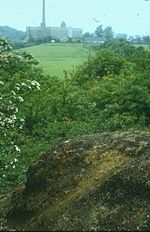Stoneclough

Stoneclough is a suburban area of Kearsley in the Metropolitan Borough of Bolton, Greater Manchester, England. It is located 3.7 miles (6 km) south-east of Bolton, 4 miles (6 km) south-west of Bury and 7.9 miles (13 km) north-west of Manchester. It is located on the banks of the River Irwell to the southeast of Bolton. Historically part of Lancashire, there are a number of listed buildings and recognised ancient monuments in the villages including Ringley Old Bridge, the village stocks, Kearsley Mill, St Saviour's Church and clock tower and the large stone railway bridge on the Manchester to Bolton railway line. The disused Manchester, Bolton and Bury Canal also passes through this area. Stoneclough is mostly residential, housing has replaced most of the old industry. These industrial sites included the Kearsley Paper Works owned by Robert Fletcher and Sons and Kearsley Power Station located on Hulme Road. These have been demolished.
Excerpt from the Wikipedia article Stoneclough (License: CC BY-SA 3.0, Authors, Images).Stoneclough
Stoneleigh Drive,
Geographical coordinates (GPS) Address Nearby Places Show on map
Geographical coordinates (GPS)
| Latitude | Longitude |
|---|---|
| N 53.545 ° | E -2.369 ° |
Address
Stoneleigh Drive
Stoneleigh Drive
M26 1HD , Stoneclough
England, United Kingdom
Open on Google Maps







